“I love anything with a killer solo you can jam out to”: Welcome to the Sophie Lloyd masterclass, where the Machine Gun Kelly guitarist and YouTube shred sensation will give your rock chops a serious workout

- Oops!Something went wrong.Please try again later.
Hello, GW readers, in this exclusive lesson, I’d like to go over my guitar parts and solo in Do or Die, a song from my upcoming album, Imposter Syndrome. But first I want to thank GuitarWorld.com readers for voting Do or Die the second-best guitar solo of 2022!
Do or Die features vocalist Nathan James, an incredible singer who’s also a very good friend of mine. The song took off right out of the gate, and it’s now at 1.9 million views on YouTube. Again, thank you to everyone for the incredible, enthusiastic response and support!
The success of Do or Die was so crazy, because the song came out at the very end of 2022 and was the first single I’d released in ages. For it to do so well on all of the platforms was great, and I’ve read Guitar World since I was a kid, so the votes from the readers meant so much to me.
Inspiration
In writing Do or Die, I was looking to create an ’80s-style classic rock song. I love that kind of music – I’m wearing an Iron Maiden T-shirt right now! – so I knew I wanted to go in that direction.
Nathan is one of my favorite vocalists and I had him specifically in mind for this song. The mindset for the style and direction of the song was along the lines of Iron Maiden, with some gallop-y palm mutes in the rhythm part.
Primary influences
Growing up, one of my favorite guitarists was Joe Satriani. He was the first player I became aware of who had made a career of writing instrumental records, all of which I thought were amazing. When I first heard Surfing with the Alien, it was the craziest album I’d ever heard, in terms of guitar techniques.
Another primary influence is Slash; he was very inspirational for this new album in particular. I love his 2010 solo album, Slash [also known as R&FN’R], with all of the collaborations with people like Ozzy Osbourne, Fergie, Chris Cornell, M. Shadows and so many incredible people.
I love Guns N’ Roses too, as well as Pantera and Black Label Society, and I also was influenced by punk music as I was growing up, including the Misfits, Social Distortion and Rancid. I love the rhythm guitar playing in all of these bands. Overall, for me it was a big mix of different things all compiled together – anything with a killer solo you can jam out to.
One of the first solos I ever learned was Stairway to Heaven. I spent months trying to learn it. Hotel California was another one, as well as Metallica’s Master of Puppets. I also worked on all of the classic Eddie Van Halen solos with fretboard tapping; I thought I was the best guitarist in the world, even though I could only play one of his tapping licks.
How to play Do or Die

Do or Die is played in the key of A minor and at a tempo of 150 beats per minute. I start the song on a C power chord in 3rd position, pedaling off the open A string (see Figure 1).
The C chord is followed by an A power chord and then a single-note lick, shown in Figure 2, which is based on the A minor pentatonic scale (A, C, D, E, G): slide up to the A note at the 5th fret on the low E string, then play C and D on the A string, bending the D note up a whole step to E and then releasing it back down to D, followed by the notes C and A. That figure repeats through the intro (Figure 3).
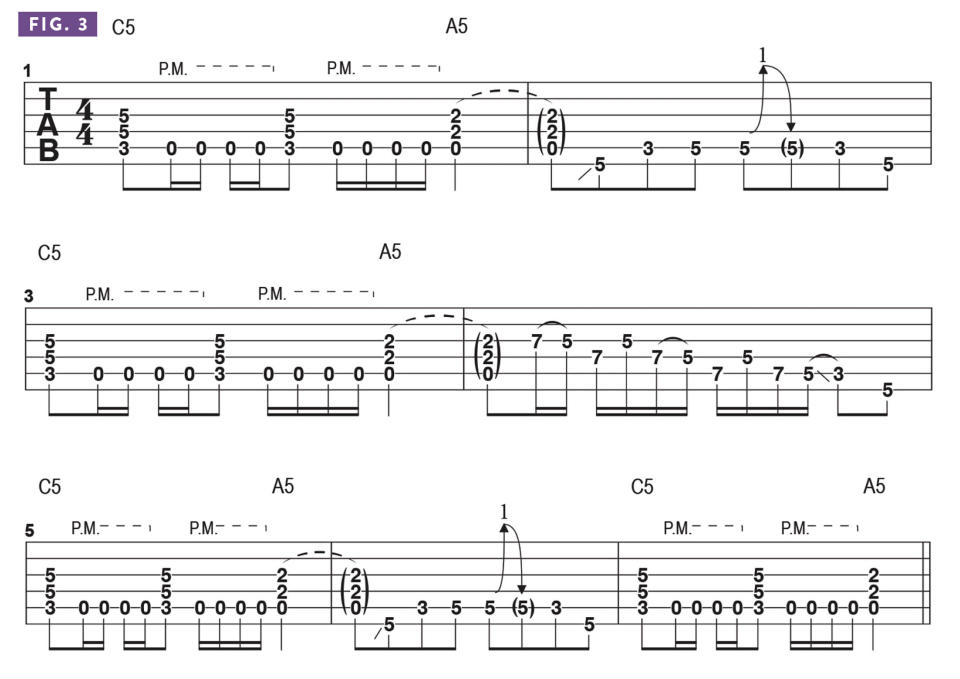
This part ends with the quick descending lick shown in Figure 4, which is also based on A minor pentatonic and is built from a sequence of pull-offs and a finger slide that move across the G, D and A strings.
Next up is the verse section, made up of the chords D5, C5 and A5 and some more open A-string pedaling (Figure 5). The second time through the two-bar phrase, I hang on the C note and add vibrato, as shown in bar 4.
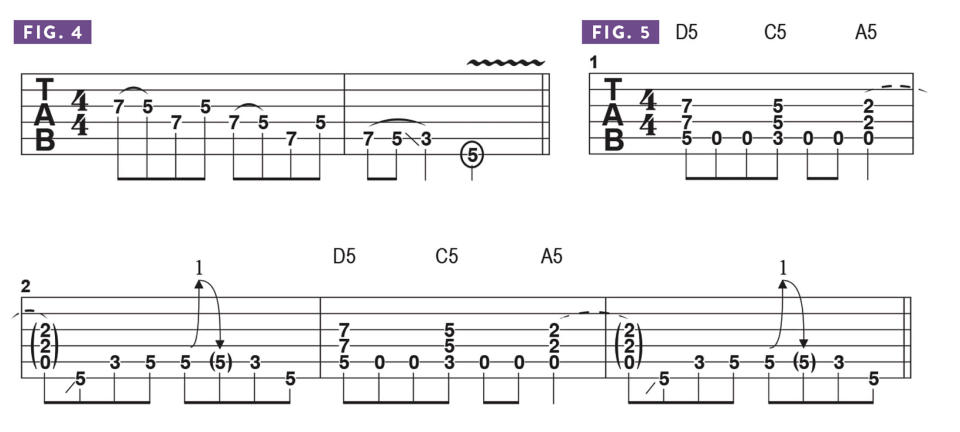
On the fourth time around, as shown in Figure 6, the phrase ends on the A5 power chord.

The pre-chorus has a few things going on. As tabbed in Figure 7, I begin with palm-muted power chords and play the progression C5 - D5 - C5 - D5 - E5 - G5, all on the A, D and G strings.

Over this part, I play a harmonized single-note line: the primary melody is played on the B string, as shown in Figure 8, and the harmony line is played on the G string (Figure 9).


The chorus guitar parts are fairly simple. The progression is A5 - G5 - D5 - A5, utilizing a down-up-down strumming pattern (Figure 10). That pattern repeats a few times while I add a higher arpeggiated pattern, tabbed in Figure 11.


On the D5 chord, I sometimes like to add the low A note on the 6th string, to fatten up the sound of the chord, so I’ll extend my index finger to barre the 6th string as well (see Figure 12).
Figure 13 presents the entire chorus section, as I perform it live.
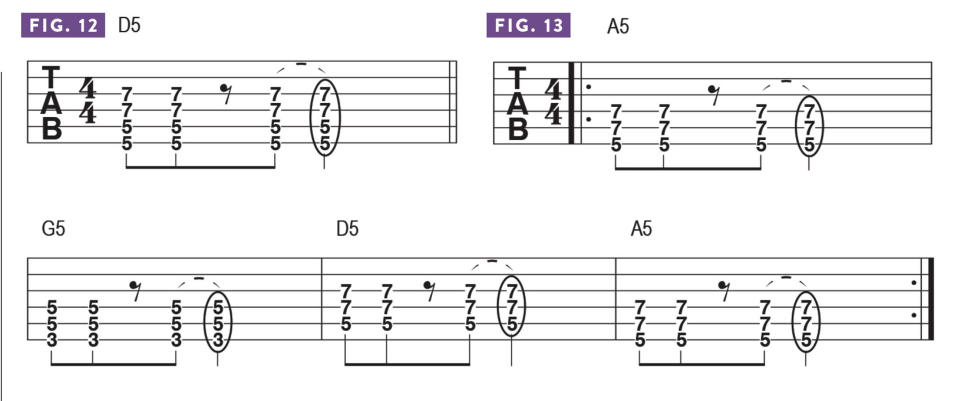
Coming out of the chorus, we add the lick shown in Figure 14, which is based on A minor pentatonic and functions as a tag for the chorus section. The arrangement then goes back to the verse, pre-chorus and chorus sections, with
the added single-note harmonized lines.
The only thing that’s different about the second chorus is that the chords go around twice before playing the chorus tag that ends the section.
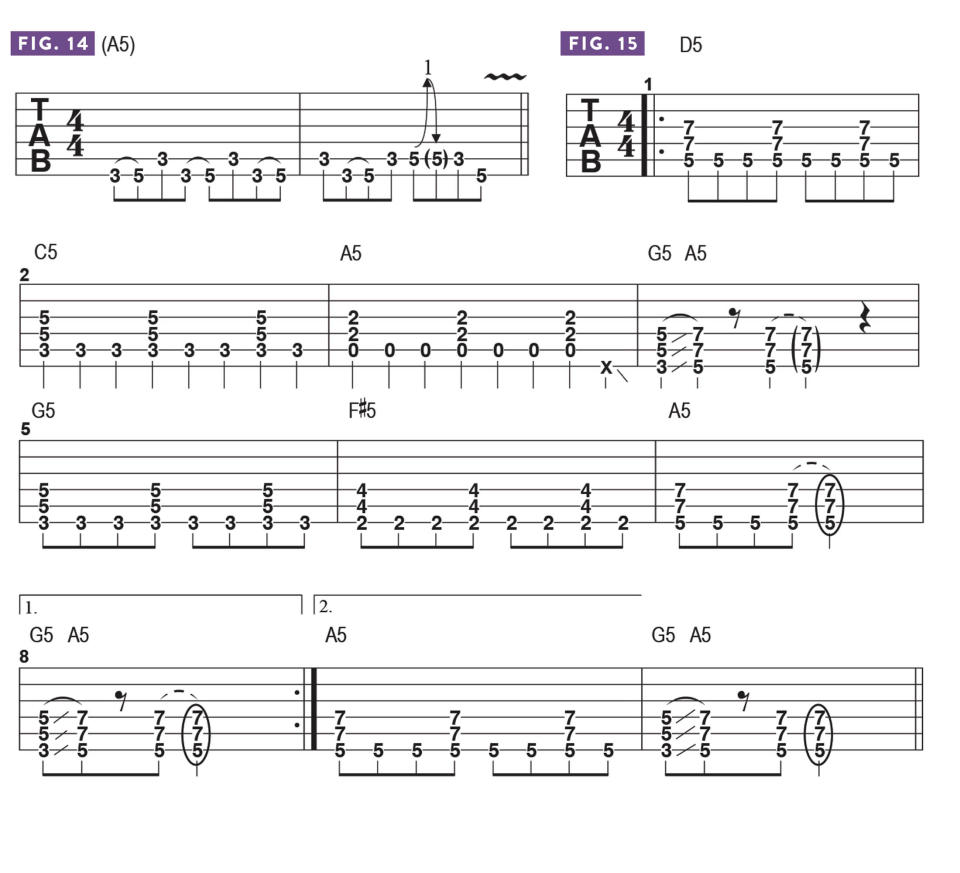
The Solo
After the second chorus tag, we come to the solo section, which is my favorite part of the song! I play the solo over a progression that’s virtually the same as that for the verses, but there are a few variations.
As shown in Figure 15, I start on D5, followed by C5 and A5, and then slide up from G5 to A5 on the bottom three strings. The progression then shifts to G5 - F#5 - A5 and another slide up from G5 to A5.
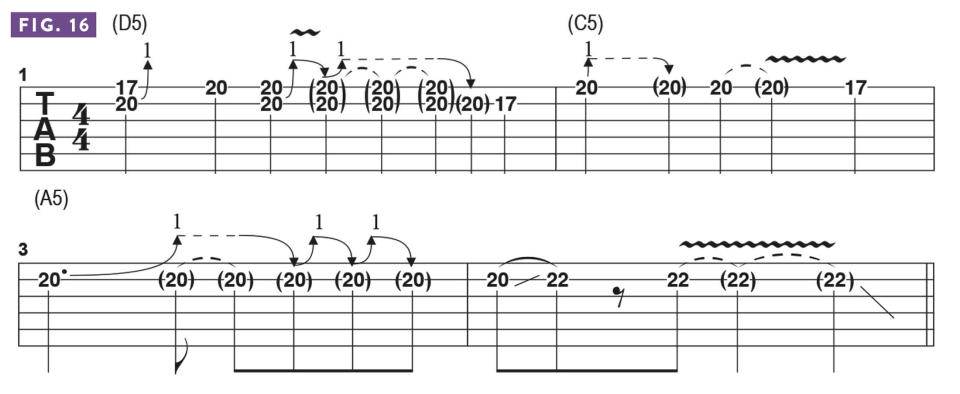
The solo is based primarily on A minor pentatonic and moves through various fretboard patterns and positions of the scale as it develops. I begin up at the 17th fret, in the “first box,” with a phrase built from bends and vibratos on the top two strings (see Figure 16).
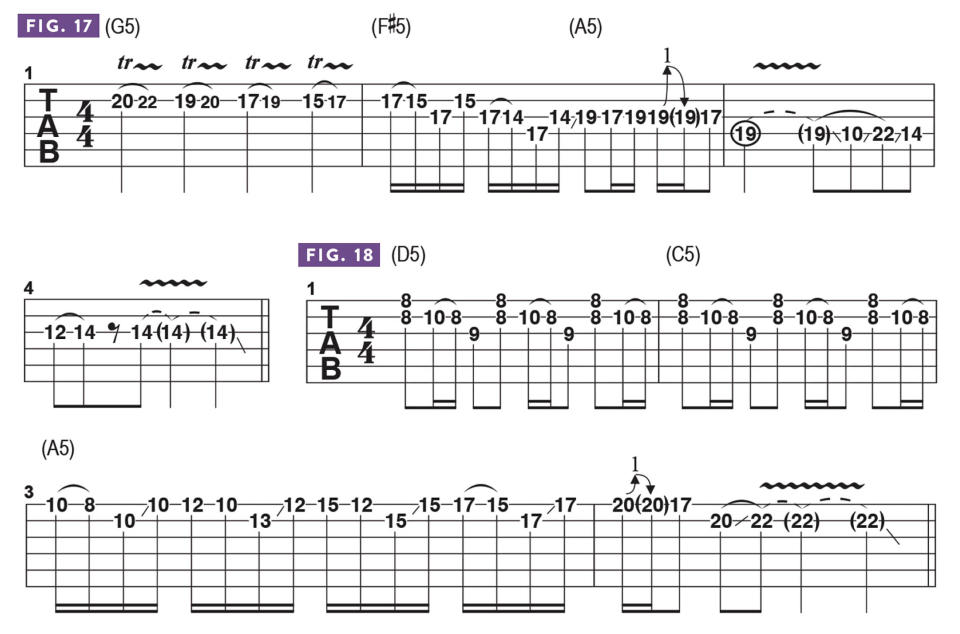
I then play a descending lick based on a repeating hammer-on/pull-off figure, illustrated in Figure 17, which is inspired by the types of solos you will hear on many Iron Maiden songs. From there, I go into Figure 18, which is a cyclic ascending pattern, played in the “second box” of A minor pentatonic.
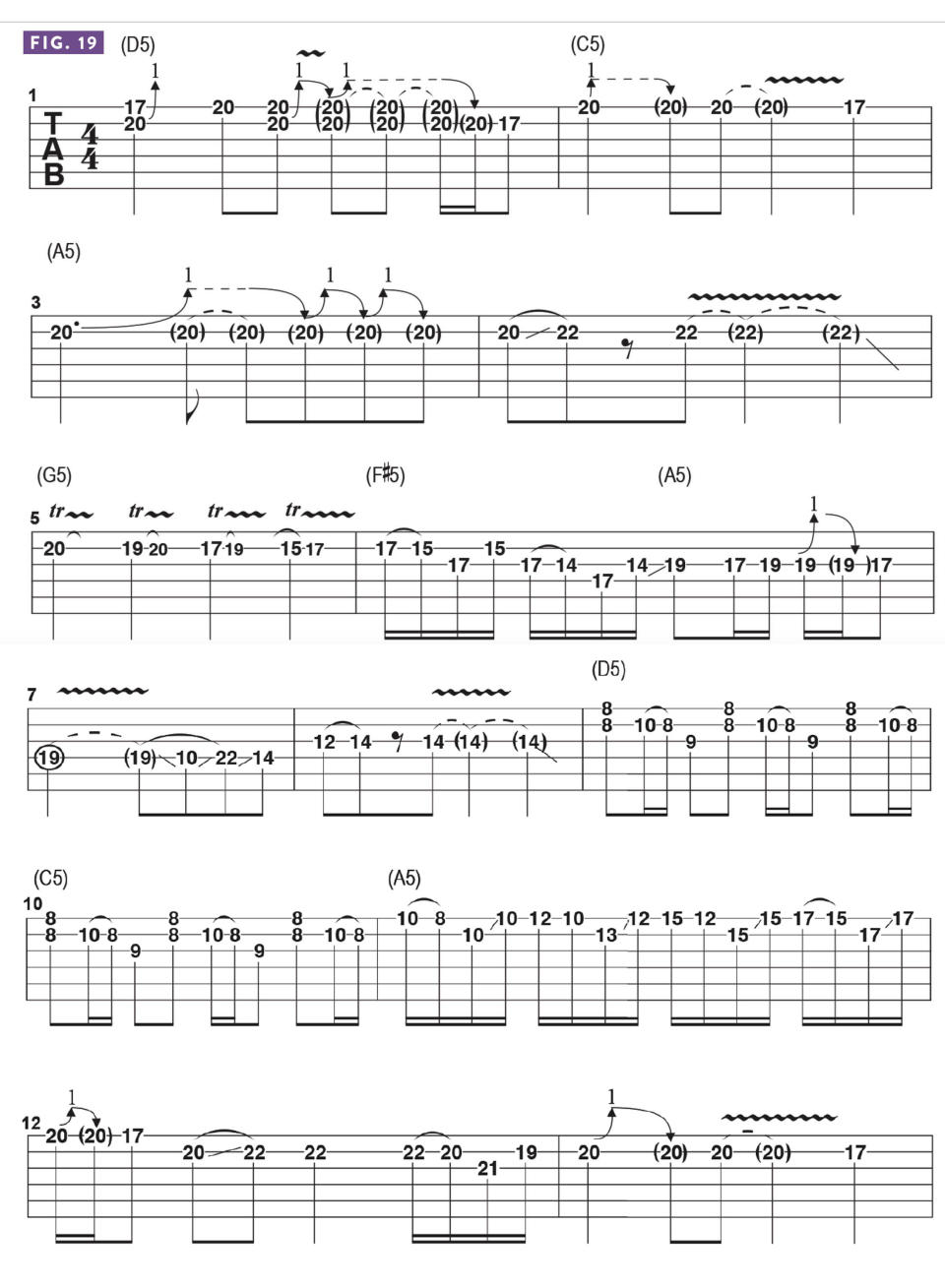
Figure 19 depicts the entire solo, as played up to speed, including the final phrase, shown in bars 13-16, which is built from a repeating motive that starts with a bend/release and then gradually moves down the A minor pentatonic scale.
The solo ends on a natural harmonic (N.H.) sounded at the 5th fret on the G string, after which I add a gradual whammy bar dive.
Outro

After the solo, we reprise the chorus, and at this point I add a new guitar part, just to mix it up a bit (see Figure 20).
That’s the song! It’s one of the simpler and more straightforward songs on the record, played in what I think of as a true “classic rock” style. I wanted to present a song that’s accessible for people to play and isn’t filled with a ton of crazy, flashy guitar playing.
Developing solo technique
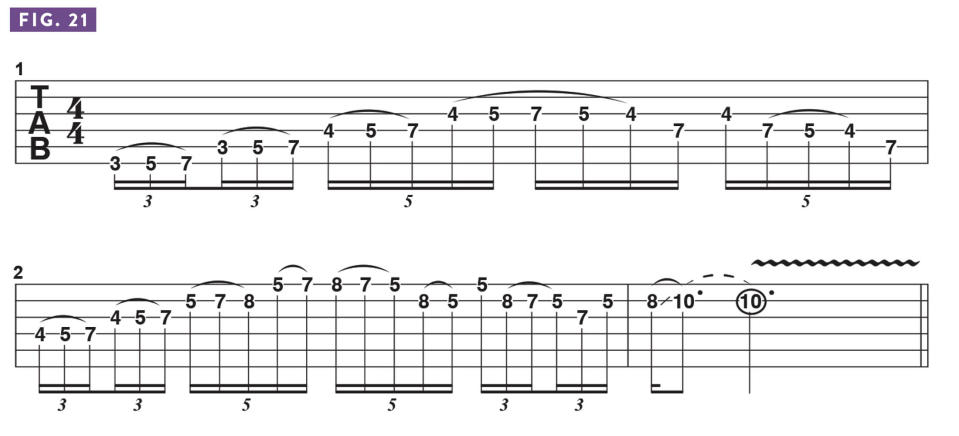
I like to work on legato phrases when I’m practicing, so the lines I play sound smooth and have a nice flow. I work on alternate and economy picking techniques as well, but I prefer the sound of legato phrases that combine hammer-ons, pull-offs and finger slides.
I picked up a lot of great legato ideas from listening to Joe Satriani and Steve Vai, specifically the ways in which they incorporate three-notes-per-string fingering patterns and scale shapes.
Figure 21 illustrates one of the typical three-notes-per-string types of phrases I like to work on. It’s based on the A Dorian mode (A, B, C, D, E, F#, G), which is made up of the same notes as the G major scale (G, A, B, C, D, E, F#). I’ll move this type of phrase all over the neck, as a workout. I find this a really effective way to work on all of the modal positions while strengthening my legato technique.
I’ll start with the Ionian mode, the major scale, and then move it up and down the fretboard, so that I can focus on various scale positions and areas of the neck. I love that sort of stuff, which you can hear in a few spots in the Do or Die solo. I use this type of legato articulation in many of my solos, as you’ll find in my soloing YouTube videos.
Picking techniques
My preference for single-note soloing is the flowing sound of legato phrases, but I also work on alternate and economy picking techniques all the time. Lately, I’ve been working on economy picking, sticking with the three-notes-per-string approach.
With economy picking, you repeat, or rather continue, the direction of the previous pick stroke when crossing to the next higher or lower string, as you would do when sweep picking, or “raking” the pick across several strings. So if the last note on a given string is picked with a downstroke, then the first note on the next higher string would also be articulated with the same downstroke.
Likewise, if the last note on a given string is picked with an upstroke, then the first note on the next lower string would also be articulated with a continuation of that upstroke.

It’s a really cool and super-efficient technique to hone, but it seems so counterintuitive to what your hands and brain want to do, and it can be challenging to train your hands to maintain a steady rhythm when using the technique in the middle of a run.
Economy picking is really helpful with playing fast – you can play crazy fast lines with economy picking – but it’s definitely a challenge to work into your picking style, until you get the hang of it.
When I was in college, I had a wonderful opportunity to take a master class with the great Frank Gambale, who introduced me to economy picking. I’ve been watching a lot of his videos lately. He’s an incredible player and musician and a true master of this exciting and very useful picking technique!

